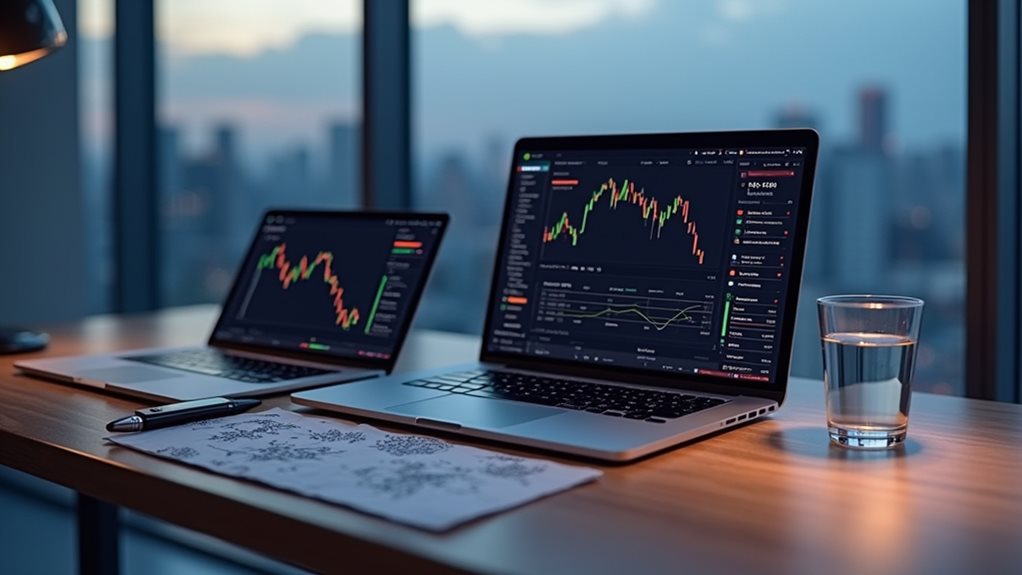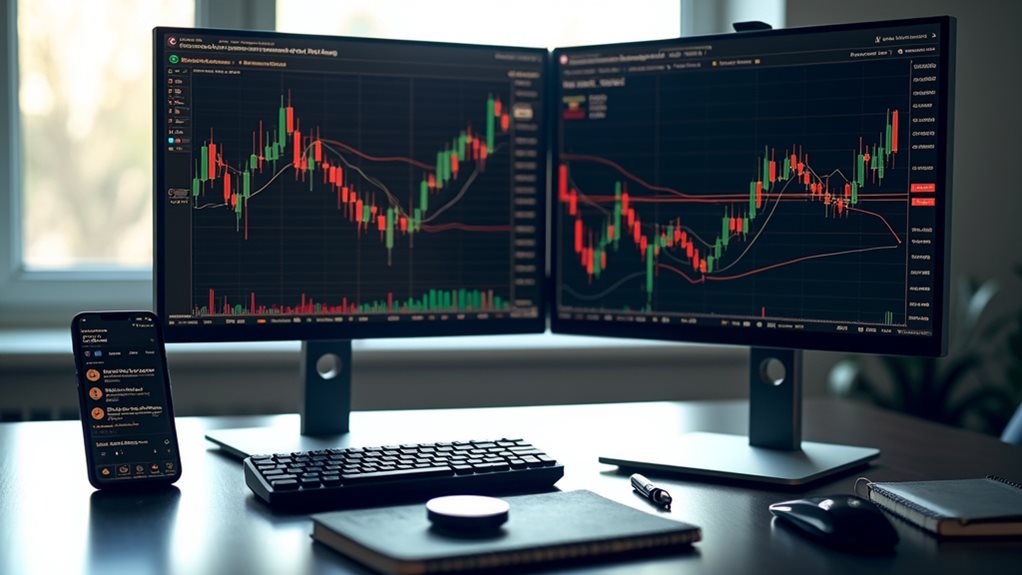Leverage trading in crypto lets you control more than you own—amplifying both potential gains and losses. You’re fundamentally borrowing money to increase your position size, but one market swing could wipe your account clean. In 2023 alone, over $1 billion got liquidated when Bitcoin dropped to $26,000. Sure, that 10x leverage looks tempting until you’re part of the liquidation cascade. Proper risk management strategies might just save your digital wallet.
What Is Crypto Leverage Trading and How Does It Work?

Power. That’s what leverage trading gives you—the ability to control more crypto than you actually own. It’s financial steroids for your trades.
Here’s the deal: you deposit funds into margin accounts as collateral. Then borrow extra capital to open leveraged positions much larger than your initial investment. Want to turn $1,000 into $10,000 of trading power? Use 10x leverage. Simple. Since crypto exchanges operate 24/7 trading windows, you can manage leveraged positions at any time.
Deposit, borrow, multiply. That’s leverage—turning pocket change into market-moving firepower with a few keystrokes.
The mechanics are brutal but straightforward. You pick a leverage ratio—2x, 5x, 10x, whatever—and suddenly your market exposure multiplies. Profits can soar. Losses too.
Your collateral backs everything. If prices move against you, expect margin calls demanding more funds. Ignore them? Say goodbye to your position—liquidated faster than you can say “crypto winter.” It’s worth noting that market volatility can trigger these margin calls even with small price movements against your position. Beginners should start with lower leverage ratios of 2x to 5x to better manage risk while learning the ropes.
The Explosive Growth of Derivatives: Market Statistics and Trends

While traditional markets plodded along at their usual pace, crypto derivatives exploded into a financial supernova.
We’re talking $8.94 trillion in monthly trading volume by 2025. Let that sink in.
Derivatives now dominate 74.2% of all crypto trading. Spot markets? They’re the sidekick now, not the hero.
Market expansion has been relentless, with annual volumes hitting $23 trillion.
Bitcoin and Ethereum aren’t just popular—they’re the prom king and queen, commanding 68% of all derivatives trades. Despite Bitcoin’s record high of $100,000 in late 2024, market volatility remains a major concern. The Asia-Pacific region has emerged as the market leader, contributing over 48% of global derivatives volume thanks to favorable regulatory environments.
Meanwhile, institutions aren’t just dipping toes anymore; they’re cannonballing into the deep end. Paradigm’s network alone accounts for over a third of Deribit’s trading volume.
The traditional derivatives market sits at $700 trillion.
Crypto’s slice? Up to $28 trillion. Not bad for the new kid.
Perpetual futures have become the dominant trading instrument in global crypto derivatives, with U.S. participants finally gaining access starting April 2025.
Understanding Risk Magnification: Liquidation Cascades Explained

Derivatives may be booming, but they’re hiding a beast beneath the surface—one that can devour your profits in seconds.
This monster? Liquidation cascades.
When market volatility spikes, it triggers a deadly domino effect. One forced sale leads to another. And another. Suddenly, everyone’s collateral thresholds are breached simultaneously. The August 2023 event saw over $1 billion in liquidations as Bitcoin plummeted to $26,000.
You think your position is safe? Think again.
Trading algorithms and stop losses kick in automatically, amplifying risk exponentially. No human intervention. No mercy. Just cold, calculated selling.
With market liquidity declining rapidly in recent months, the risks of getting trapped in a cascade have never been higher.
Margin calls flood in, and if you can’t answer? Goodbye position.
The worst part? Price slippage gets ridiculous during these events. Your liquidation price? Yeah, you’ll get way less.
It’s a vicious cycle—each liquidation pushes prices lower, triggering more liquidations. Circuit breakers implemented by some exchanges can temporarily halt trading during these panics, but they’re not foolproof.
Pretty neat system, huh? Not when you’re caught in it.
Modern Platform Features That Drive Margin Trading Adoption

Beyond all the warnings and risks, crypto platforms have crafted an irresistible candy store of features to lure you into margin trading.
Slick user interfaces mask complexity, while mobile accessibility means you can destroy your portfolio from literally anywhere. Fancy that.
They’ve nailed gamification elements too—trading competitions and rewards that make financial risk feel like a video game.
Multi-signature wallets add an extra layer of security for large margin trades, requiring multiple approvals before execution.
High-octane fun!
Advanced analytics and algorithmic trading tools seduce the data nerds. OKX and Binance have established themselves as leaders with their up to 100x leverage options for futures trading.
TradingView integration, 100x leverage options, real-time dashboards—all designed to make you feel like a Wall Street wizard.
Meanwhile, risk controls provide the illusion of safety.
Community engagement features let novices copy experienced traders’ moves.
And decentralized funding options? Just another way crypto platforms keep you plugged in, borrowing more, trading more.
These platforms will issue margin call notifications when your funds approach dangerous levels, but by then it’s often too late to recover your position.

All those flashy trading features might make you feel invincible, but there’s a reason platforms design them that way—they operate in regulatory gray zones where rules are constantly shifting.
Since 2025, the SEC and CFTC have tried creating regulatory clarity with their joint statement on spot crypto margin products. Sounds promising, right? Except it’s just an interpretation, not actual law.
Regulators offer “clarity” that’s about as solid as a crypto whitepaper—all promises, no guarantees.
Meanwhile, FinCEN watches your every move for money laundering. The Travel Rule means your $3,000+ transactions need your personal info attached. Fun!
Under the SEC’s new crypto stance, enforcement actions against major trading platforms have been paused while regulations evolve.
Compliance challenges abound as platforms maneuver through this regulatory mess. No wonder Coinbase ditched margin trading completely.
Kraken stuck with it, but at what cost?
State regulations add another layer to this bureaucratic nightmare. New York’s BitLicense framework has forced many crypto platforms to exclude residents from margin trading services. The joint statement specifically addresses products involving leverage and margin trading, bringing some much-needed clarity to this segment. Welcome to crypto in America—where everything’s legal but impossible.
Institutional Players: How Big Money Uses Leverage Differently

Three letters separate institutional crypto traders from retail gamblers: R-O-I. While you’re YOLOing into 100x positions, institutions deploy institutional leverage with surgical precision.
They’re not gambling – they’re executing. Their trading algorithms handle 76% of volume through derivatives, carefully balancing risk assessment against potential returns. Crazy, right?
These whales allocate a whopping 86% of portfolios to crypto assets, using margin strategies that rarely exceed moderate leverage ratios. No 50x moonshots here.
Their market influence isn’t accidental. It’s calculated. Strategic positioning across isolated and cross margin allows for portfolio optimization without catastrophic liquidation risks.
Remember the $151 billion September 2025 crash? That’s what happens when even the pros get liquidity management wrong. Big money, big mistakes.
Similar to the Crypto Task Force established by the SEC, institutional players have developed robust regulatory compliance systems.
Approximately 72% of these institutional players have developed enhanced risk frameworks to protect their investments during market turbulence.
Institutions frequently utilize OTC trading to execute large-volume transactions with minimal market impact while maintaining price stability.
Risk Management Strategies for Leveraged Positions

While margin trading can amplify your gains, it’ll absolutely destroy your portfolio without proper risk management.
Set stop loss strategies to automatically exit when the market turns against you—no more emotional decision making when prices tank. Combine with take profit tactics to lock in wins before inevitable corrections.
Emotional trading kills portfolios. Let automated stop losses and take profit orders make the tough calls for you.
Choose your margin type wisely. Isolated margin contains disasters. Cross margin offers collateral efficiency but spreads risk like wildfire.
Automated orders are your safety net during market shocks when you’re asleep or distracted. Trust me, you’ll need them.
Keep leverage caps low, especially if you’re new. High leverage is financial skydiving without checking your parachute. Remember that higher leverage means less margin required as collateral, significantly increasing your liquidation risk.
Regular margin monitoring extends position longevity and helps you avoid those lovely 3 AM liquidation calls. Your future self will thank you.
Define clear risk-reward parameters for every trade to avoid emotional decisions when entire account balance is at stake with cross margin trading.
DeFi vs. CeFi: Comparing Margin Trading Options Across Ecosystems

Risk management tames the leverage beast, but your next choice is equally important: where to do your margin trading. CeFi and DeFi offer radically different experiences. Yeah, they’re both crypto, but that’s where similarities end.
- Custody models matter – CeFi holds your keys (convenient but risky), while DeFi lets you control assets (freedom with responsibility). Their security measures reflect this fundamental difference. Traditional banks are now joining the crypto ecosystem, bringing established custody solutions to the market.
- User experience gaps are real – CeFi advantages include intuitive interfaces and customer support. DeFi challenges you with complex protocols and self-reliance. Trading complexity increases with decentralization. CeFi platforms typically offer more stable yields between 5-10% APY, making them attractive for less volatile margin strategies. CeFi’s growing market share of 34.57% by Q1 2025 demonstrates the increasing preference for centralized lending options despite DeFi’s previous dominance.
- Regulatory impacts shape everything – CeFi operates under oversight with KYC requirements limiting access. DeFi? Permissionless but unprotected. Liquidity differences follow these patterns – CeFi’s centralized pools versus DeFi’s fragmented AMMs.
The choice affects your risk exposure. Choose wisely.
Beyond Bitcoin: Altcoin Derivatives and Emerging Product Innovations

Bitcoin’s reign as king of crypto derivatives is officially over. Ethereum futures hit $62.1 billion in 2025, edging out Bitcoin’s $61.7 billion. That’s huge.
The crypto throne has a new occupant as ETH derivatives officially dethrone Bitcoin’s long-standing dominance.
The altcoin derivatives environment is exploding beyond simple futures. You’ve now got perpetual swaps, leveraged tokens, and complex options on everything from Solana to Avalanche.
Institutional adoption is ramping up fast, with regulated markets seeing billions in open interest. Solana’s high transaction speed and low fees make it particularly attractive for sophisticated derivatives trading. With cold storage security becoming standard practice among institutional traders, the market is seeing increased confidence from major players.
Why? Altcoin volatility. Traders love it. DeFi protocols are weaving these instruments into structured products that blend traditional finance with crypto innovation. It’s not merely for degens anymore.
But let’s be real—these markets come with serious risks. Liquidity is still patchy for smaller coins, and regulators haven’t figured out what to do with all this innovation yet. Investors should understand that all investing involves risk, including the potential loss of principal in these highly volatile markets.
Proceed accordingly.
Building a Sustainable Strategy: Balancing Risk and Reward

Despite all the glitz of crypto trading, sustained success comes down to cold, hard numbers. Your risk reward analysis isn’t just fancy trader talk—it’s your lifeline when markets go haywire. Set those ratios between 1:2 and 1:5, and stick to them. Seriously. Setting realistic targets based on technical analysis will improve your entry and exit points significantly.
Emotional decision making is your worst enemy. It’ll wreck your account faster than a bearish tweet from Elon. Modern AI trading signals help eliminate emotional trading behaviors that lead to costly mistakes. Traders must maintain a maintenance margin to keep positions active and avoid the liquidation process.
Here’s what separates the survivors from the rekt:
- Automated stop-losses and take-profits that execute without your feelings getting involved
- Position sizing that keeps you in the game (1-2% per trade, not your entire bankroll, genius)
- Diversification across uncorrelated assets to level out the inevitable bumps
Leverage is powerful, but remember—it’s also a magnificent way to get liquidated.
Frequently Asked Questions
How Do Funding Rates Affect Profitability in Perpetual Futures Contracts?
Funding mechanisms directly impact your profitability assessment since you’ll pay fees when holding positions against market dynamics. You should incorporate funding rates into your trading strategies to avoid unexpected costs eroding your potential profits.
What Psychological Biases Commonly Lead to Overleveraging in Crypto Markets?
You’re likely to overleverage when confirmation bias makes you ignore negative signals and loss aversion pushes you to recover losses. FOMO, overconfidence, herding behavior, and anchoring to past prices intensify these tendencies.
How Do Market Makers Influence Liquidation Prices on Margin Trading Platforms?
Market makers influence liquidation prices by strategically adjusting liquidity around concentrated position clusters, creating market dynamics that can trigger liquidations. They’ll often use liquidation maps to guide prices toward zones with high liquidation triggers.
Can Tax Implications Differ Between Spot Trading and Leveraged Position Profits?
Yes, your tax treatment differs considerably. Leveraged trading may be taxed as business income with deductible expenses, while spot profits get capital gains classification. You’ll face different reporting requirements for each activity.
How Does Exchange Insurance Protect Leveraged Positions During System Outages?
During outages, the exchange’s insurance fund covers losses beyond your collateral, providing liquidation protection when positions can’t be closed timely. These insurance mechanisms prevent auto-deleverage liquidations and protect you from devastating deficit balances.








